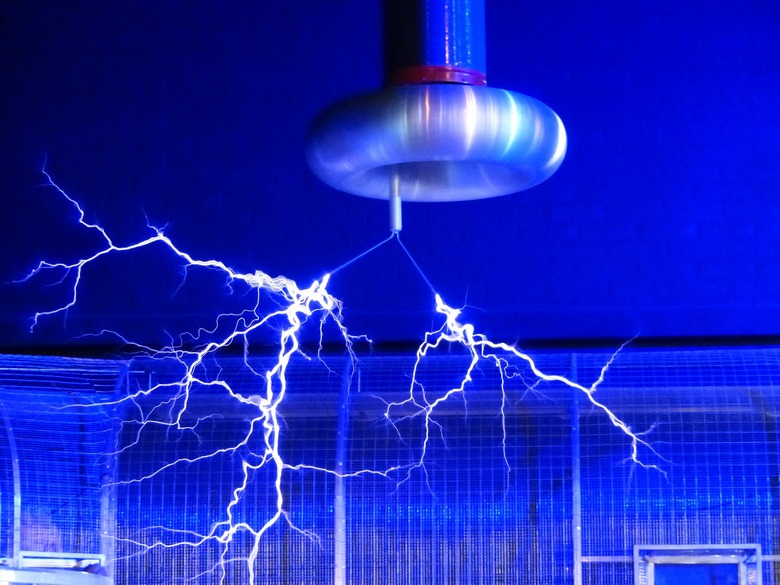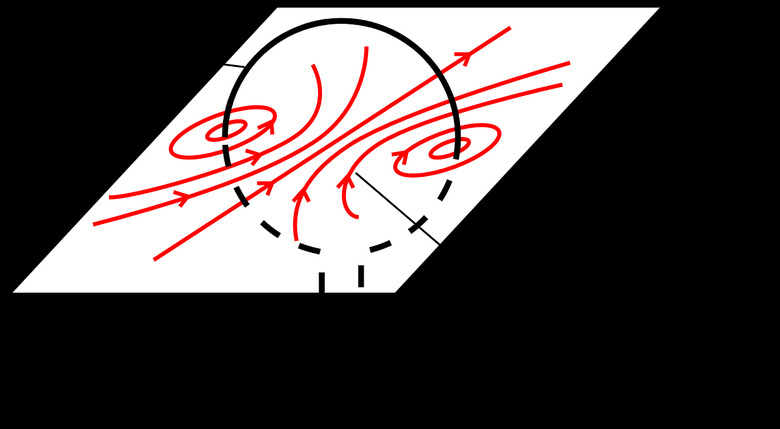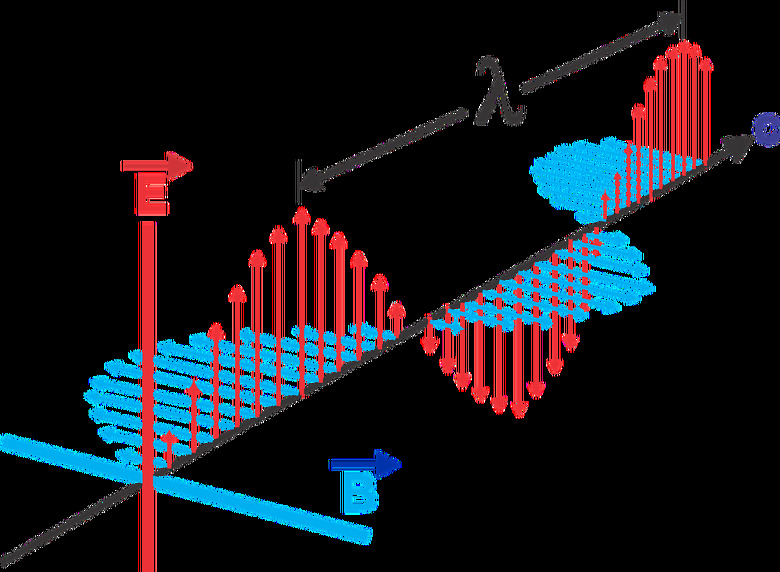What Are 3 Similarities Between Magnets And Electricity?
Electric and magnetic forces are two forces found in nature. While at first glance they may seem different, they both originate from fields associated with charged particles. The two forces have three main similarities, and you should learn more about how these phenomena arise.
1 – They Come in Two Opposite Varieties
1 – They Come in Two Opposite Varieties
Charges come in positive (+) and negative (-) varieties. The fundamental positive charge carrier is the proton and the negative charge carrier is the electron. Both have a charge of magnitude e = 1.602 × 10-19 Coulombs.
Opposites attract, and likes repel; two positive charges placed near each other will repel, or experience a force which pushes them apart. The same is true of two negative charges. A positive and a negative charge, however, will attract each other.
The attraction between positive and negative charges is what tends to make most items electrically neutral. Because there are the same number of positive as negative charges in the universe, and the attractive and repulsive forces act the way they do, the charges tend to neutralize, or cancel each other out.
Magnets, similarly, have north and south poles. Two magnetic north poles will repel each other as will two magnetic south poles, but a north pole and south pole will attract each other.
Note that another phenomenon you are likely familiar with, gravity, is not like this. Gravity is an attractive force between two masses. There is only one "type" of mass. It doesn't come in positive and negative varieties like electricity and magnetism do. And this one type of mass is always attractive and not repulsive.
There is a distinct difference between magnets and charges, however, in that magnets always appear as a dipole. That is, any given magnet will always have a north and south pole. The two poles cannot be separated.
An electric dipole can also be created by placing a positive and negative charge at some small distance apart, but it is always possible to separate these charges again. If you imagine a bar magnet with its north and south poles, and you were to try to cut it in half to make a separate north and south, instead the result would be two smaller magnets, both with their own north and south poles.
2 – Their Relative Strength Compared to Other Forces
2 – Their Relative Strength Compared to Other Forces
If we compare electricity and magnetism to other forces, we see some distinct differences. The four fundamental forces of the universe are the strong, electromagnetic, weak and gravitational forces. (Note that electric and magnetic forces are described by the same single word – more on this in a bit.)
If we consider the strong force – the force that holds nucleons together inside of an atom – to have a magnitude of 1, then electricity and magnetism have a relative magnitude of 1/137. The weak force – which is responsible for beta decay – has a relative magnitude of 10-6, and the gravitational force has a relative magnitude of 6 × 10-39.
You read that right. It wasn't a typo. The gravitational force is extremely wimpy compared to everything else. This might seem counterintuitive – after all, gravity is the force that keeps planets in motion and keeps our feet on the ground! But consider what happens when you pick up a paperclip with a magnet or a tissue with static electricity.
The force pulling up the one little magnet or statically charged item can counteract the gravitational force of the entire Earth pulling on the paperclip or tissue! We think of gravity as being so much more powerful not because it is, but because we have the gravitational force of an entire globe acting on us at all times whereas, due to their binary nature, charges and magnets often arrange themselves so that they are neutralized.
3 – Electricity and Magnetism Are Two Sides of the Same Phenomenon
3 – Electricity and Magnetism Are Two Sides of the Same Phenomenon
If we look more closely and really compare electricity and magnetism, we see that on a fundamental level they are two aspects of the same phenomenon called electromagnetism. Before we fully describe this phenomenon, lets get a deeper understanding of the concepts involved.
Electric and Magnetic Fields
Electric and Magnetic Fields
What is a field? Sometimes it is helpful to think about something that seems more familiar. Gravity, like electricity and magnetism, is also a force that creates a field. Imagine the region of space around the Earth.
Any given mass in space will feel a force that depends on the magnitude of its mass and its distance from the Earth. So we imagine that the space around Earth contains a field, that is, a value assigned to each point in space that gives some indication of how relatively big, and in what direction, a corresponding force would be. The magnitude of the gravitational field a distance r from mass M, for example, is given by the formula:
\(E= {GM\above{1pt} r^2}\)
Where G is the universal gravitational constant 6.67408 × 10-11 m3/(kgs2). The direction associated with this field at any given point would be a unit vector pointing towards the center of the Earth.
Electric fields work in the same way. The magnitude of the electric field a distance r from point charge q is given by the formula:
\(E= {kq\above{1pt} r^2}\)
Where k is the Coulomb constant 8.99 × 109 Nm2/C2. The direction of this field at any given point is towards the charge q if q is negative, and away from charge q if q is positive.
Note that these fields obey an inverse square law, so if you move twice as far away, the field becomes one-quarter as strong. To find the electric field generated by several point charges, or a continuous distribution of charge, we would simply find the superposition or perform an integration of the distribution.
Magnetic fields are a little trickier because magnets always come as dipoles. A magnitude of the magnetic field is often represented by the letter B, and the exact formula for it depends on the situation.
So Where Does Magnetism Really Come From?
So Where Does Magnetism Really Come From?
The relationship between electricity and magnetism wasn't apparent to scientists until several centuries after the initial discoveries of each. Some key experiments exploring the interaction between the two phenomena eventually led to the understanding we have today.
Current Carrying Wires Create a Magnetic Field
Current Carrying Wires Create a Magnetic Field
In the early 1800s scientists first discovered that a magnetic compass needle could be deflected when held near a wire carrying current. It turns out that a current carrying wire creates a magnetic field. This magnetic field a distance r from an infinitely long wire carrying current I is given by the formula:
\(B= {\mu_0 I\above{1pt} 2\pi r}\)
Where μ0 is the vacuum permeability 4π × 10-7 N/A2. The direction of this field is given by the right hand rule – point the thumb of your right hand in the direction of the current, and then your fingers wrap around the wire in a circle indicating the direction of the magnetic field.
This discovery led to the creation of electromagnets. Imagine taking a current carrying wire and wrapping it into a coil. The direction of the resulting magnetic field will look like the dipole field of a bar magnet!
But What About Bar Magnets? Where Does Their Magnetism Come From?
But What About Bar Magnets? Where Does Their Magnetism
Come From?
Magnetism in a bar magnet is generated by the motion of the electrons in the atoms that comprise it. The moving charge in each atom creates a small magnetic field. In most materials, these fields are oriented every which way, resulting in no significant net magnetism. But in certain materials, such as iron, the material composition allows for these fields to all become aligned.
So magnetism is really a manifestation of electricity!
But Wait, There’s More!
But Wait, There's More!
It turns out that not only does magnetism result from electricity, but electricity can be generated from magnetism. This discovery was made by Michael Faraday. Shortly after the discovery that electricity and magnetism were related, Faraday found a way to generate current in a coil of wire by varying the magnetic field passing through the center of the coil.
Faraday's law states that the current induced in a coil will flow in a direction that opposes the change that caused it. What is meant by this is that the induced current will flow in a direction that generates a magnetic field that opposes the changing magnetic field that caused it. In essence, the induced current is simply trying to counteract any field changes.
So if the external magnetic field is pointing into the coil and then increases in magnitude, the current will flow in such a direction to create a magnetic field pointing out of the loop in order to counteract this change. If the external magnetic field is pointing into the coil and decreases in magnitude, then the current will flow in such a direction to create a magnetic field that also points into the coil in order to counteract the change.
Faraday's discovery led to the technology behind today's power generators. In order to generate electricity, there needs to be a way to vary the magnetic field passing through a coil of wire. You can imagine turning a wire coil in the presence of a strong magnetic field in order to enact this change. This is often done by mechanical means, such as a turbine being moved by wind or flowing water.
Similarities Between Magnetic Force and Electric Force
Similarities Between Magnetic Force and Electric Force
The similarities between magnetic force and electric force are many. Both forces act on charges and have their origins in the same phenomenon. Both forces have comparable strengths, as described above.
Electric force on charge q due to field E is given by:
\(\vec{F}=q\vec{E}\)
The magnetic force on charge q moving with velocity v due to field B is given by the Lorentz force law:
\(vec{F}=q\vec{v}\times\vec{B}\)
Another formulation of this relationship is:
\(vec{F}= \vec{I} L\times\vec{B}\)
Where I is the current and L the length of wire or conductive path in the field.
In addition to the many similarities between magnetic force and electric force, there are also some distinct differences. Note that the magnetic force will not affect a stationary charge (if v = 0, then F = 0) or a charge moving parallel to the direction of the field (which results in a 0 cross product), and in fact the degree to which the magnetic force acts varies with the angle between the velocity and the field.
Relationship Between Electricity and Magnetism
Relationship Between Electricity and Magnetism
James Clerk Maxwell derived a set of four equations that summarize the relationship between electricity and magnetism mathematically. These equations are as follows:
\(\triangledown \cdot\vec{E}=\dfrac{\rho}{\epsilon_0}\
\text{ }\
\triangledown \cdot\vec{B}=0\
\text{ }\
\triangledown \times\vec{E}=-\dfrac{\partial\vec{B}}{\partial t}\
\text{ }\
\triangledown \times\vec{B}=\mu_0\vec{J}+\mu_0\epsilon_0\dfrac{\partial\vec{E}}{\partial t}\)
All of the phenomena discussed previously can be described with these four equations. But even more interesting is that after their derivation, a solution to these equations was found that didn't seem consistent with what was previously known. This solution described a self-propagating electromagnetic wave. But when the speed of this wave was derived, it was determined to be:
\(\dfrac{1}{\sqrt{\epsilon_0\mu_0}}=299,792,485 m/s\)
This is the speed of light!
What is the significance of this? Well, it turns out that light, a phenomenon scientists had been exploring the properties of for quite some time, was actually an electromagnetic phenomenon. This is why today you see it referred to as electromagnetic radiation.
Cite This Article
MLA
TOWELL, GAYLE. "What Are 3 Similarities Between Magnets And Electricity?" sciencing.com, https://www.sciencing.com/3-similarities-between-magnets-electricity-8105339/. 27 December 2020.
APA
TOWELL, GAYLE. (2020, December 27). What Are 3 Similarities Between Magnets And Electricity?. sciencing.com. Retrieved from https://www.sciencing.com/3-similarities-between-magnets-electricity-8105339/
Chicago
TOWELL, GAYLE. What Are 3 Similarities Between Magnets And Electricity? last modified March 24, 2022. https://www.sciencing.com/3-similarities-between-magnets-electricity-8105339/



